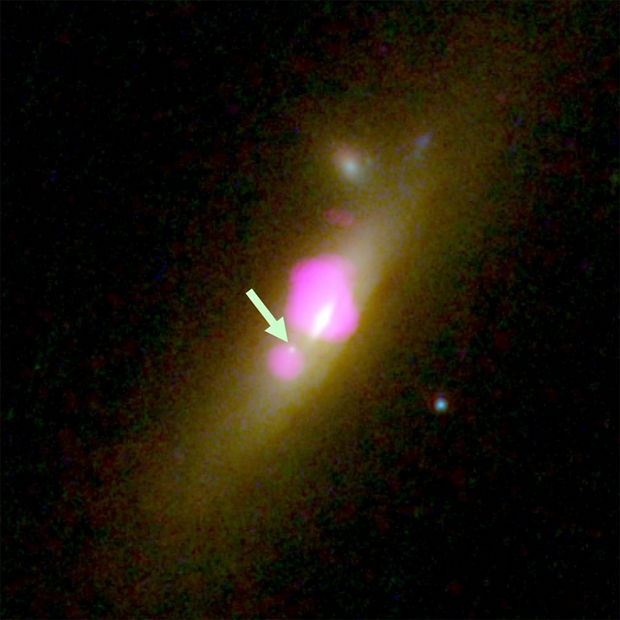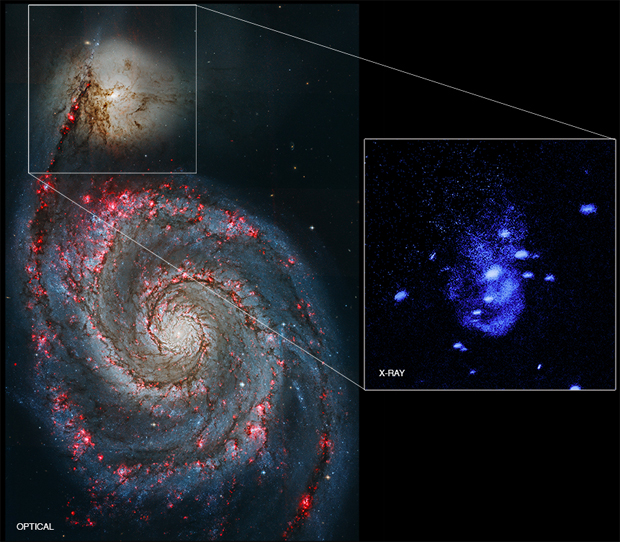Dueling black holes strange bedfellows in galaxy merger
Galaxies in the process of colliding and merging are not uncommon, but detecting and studying two post-merger black holes in the relatively brief period before they coalesce into a single supermassive hole is a major challenge. One such galaxy comes with an added bonus, an astronomer said Tuesday: a rare, possible intermediate-mass black hole.
Supermassive black holes are thought to lurk in the cores of all large galaxies, containing the mass of one million to one billion or more suns. The mass of the hole is proportional to the mass of the galaxy and when galaxies merge, their black holes merge as well, generating gravitational waves in the fabric of spacetime.
Galaxies "merge all the time, but this phase where the two black holes are separated doesn't last that long," Julie Comerford, an assistant professor of astronomy at the University of Colorado at Boulder, told reporters at the American Astronomical Society's winter meeting in Kissimmee, Fla.
"It lasts maybe 100 million years, which sounds like a long time but in the universe's scale it's not, it's the blink of an eye. That's why they're hard to find. Most galaxies go through this phase, but it's a very short-lived phase."
Sifting through countless galactic spectra, Comerford and her colleagues found a galaxy known as SDSS J1126+2944 that was formed by the merger of two smaller galaxies, each one featuring its own black hole. One of the black holes in the merged galaxy is embedded in a typically rich swarm of stars while the other is not.
"One black hole is starved of stars, and has 500 times fewer stars associated with it than the other black hole," Comerford said in a news release. "The question is why there's such a discrepancy."
Speaking with reporters, she said there are two possible explanations. During the merger, extreme gravitational and tidal forces may have simply pulled away most of the stars from the now nearly "naked" black hole.
The other possibility is that Comerford and her fellow researchers have found a rare intermediate-mass black hole with a mass between 100 and 100 million times that of the sun, a much more difficult quarry to pin down. Intermediate-mass black holes are believed to reside in smaller dwarf galaxies.
"There's a lot of evidence that there are intermediate-mass black holes, but it's really hard to prove something is in that mass range and not a supermassive black hole or something else," Comerford said.
"If we get the radio and X-ray observations that show it's an intermediate mass black hole then that would be a really strong one to add to the growing file of intermediate black holes."
Comerford's team found the galaxy in question by sifting through galaxy spectra showing a tell-tale "double peak" indicating material moving around two black holes.
"I like galaxies with two black holes in them, that's my thing, and so I have a way of finding candidates for galaxies that I think might have two black holes," she said. "I look at the spectrum of a galaxy and there are emission lines that come from the black holes."
The light from stars orbiting a supermassive black hole and from dust heated up as it is accelerated into oblivion is shifted toward the red end of the spectrum when the emitting body is moving away from the detector and toward the blue region of the spectrum when it is approaching.
In galaxies with two black holes, "you should see one more red-shifted line and one more blue-shifted line," Comerford said. "You should see a double-peaked line profile in the spectrum. So I went through and looked through millions of spectra for ones that have this double-peaked profile."
Then she applied for observing time on the Hubble Space Telescope and NASA's Chandra X-ray Observatory "to see if they really do have two black holes."
"It's like opening a Christmas present, you never know what the data's going to look like," she said. "I'm always excited when I see two black holes, but this one was like an extra bonus."
While supermassive black holes are generally thought to be one-way portals to an unknowable interior, they also generate intense radiation pressure and jets that can fling in-falling material back out into surrounding space.
In the famous Whirlpool system, a large face-on spiral galaxy and a smaller, dust-shrouded companion known as NGC 5195 are in the process of merging. Astronomers studying the smaller galaxy with the Chandra X-ray Observatory have found two huge arcs of X-ray emissions near the center.
The emissions represent "fossils from two enormous blasts when the black hole expelled material outward into the galaxy," Christine Jones of the Harvard-Smithsonian Center for Astrophysics, said in a release at the AAS meeting. "This activity is likely to have had a big effect on the galactic landscape."
Eric Schlegel of The University of Texas in San Antonio led the study and provided this analogy: "astronomers often refer to black holes as 'eating' stars and gas. Apparently, black holes can also burp after their meal."
Such blasts can eject gas from a galaxy, serving as a sort of feedback loop to limit a galaxy's size. But as the shock waves from a blast moves through the surrounding medium, they also can trigger star formation.
"We think that feedback keeps galaxies from becoming too large," said co-author Marie Machacek. "But at the same time, it can be responsible for how some stars form. This shows that black holes can create, not just destroy."
Schlegel said the Whirlpool observations are important "because this behavior would likely happen very often in the early universe, altering the evolution of galaxies. It is common for big black holes to expel gas outward, but rare to have such a close, resolved view of these events."


